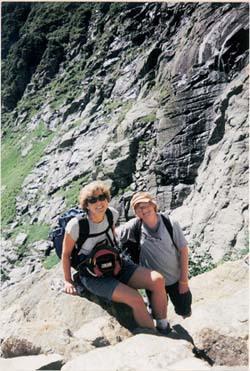 |
 |
| current issue |  |
past issues |  |
send a letter/news |  |
address update |  |
advertise |  |
about us |  |
alumni home |
Features
The Lure of TuckermanPage 3 of 3
The risk of avalanche dims in the spring as the snow melts, but Chris Joosen, a ranger for the U.S. Forest Service who spends nearly every day between Nov. 1 and June 1 in Tuckerman Ravine, maintains his avalanche warning system—on Web sites, at the Appalachian Mountain Club visitor center in Pinkham Notch, at Hermit Lake Shelter—until the snow is gone.
Of greater threat in spring is ice. Each year tons of ice form on the headwall, in the gullies, and on large swatches of the bowl. As the sun melts the snow, it also melts the ice. But it leaves the ravine in chunks, not in gentle drips. The first death in Tuckerman, in fact, was from falling ice. On July 24, 1886, 15-year-old Sewall Faunce was killed when the infamous "Snow Arch"—a bridge of ice and snow—collapsed as he stood underneath.

|
While skiers and hikers are warned relentlessly to stay away from the Snow Arch and icy ledges, flying ice chunks are an integral part of a Tuckerman trek. One spring day during her senior year, Cindy Conlin '92 stopped at the lunch rocks for a break after skiing one of the chutes. While the lunch rocks are the most popular spot to observe other skiers, they are also in a direct line from ice breaking off the ravine's center wall and the Sluice. "Not a great place to sit," says Joosen.
Conlin was wise; she watched for ice. And when she saw a skier dodge a piece the size of a dishwasher, she looked for a rock to hide behind. She was safe, but the ice chunk rolled over a 5-year-old boy as he ran to his mother. He was bruised and scared, but otherwise—miraculously—okay. "All of a sudden the danger was so real," Conlin says.
Dave Cohen '54 suffered his own near-collision with ice on his first trip to the ravine three years after he left UNH. He says he wanted to see "if I could handle a slope that dropped faster than it progressed horizontally." He heard the bang, then the thumps as he scaled the headwall. A man-sized chunk of ice rolled towards him. He and the line of skiers moved sideways. It rolled past. He skied down in "10 long scary seconds" and packed up. Still, he returned again the next year. "It's the adventure," he says.
As we scramble up rocks and a narrow dirt path, I assess the gamble. If Luke rises to the challenge, he could gain the confidence that comes with achievement. But if he crumbles, he could hate hiking forever—and me temporarily. Or worse.
We have achieved our initial goal: We reach Tuckerman Ravine. Walking into its floor, we look up and soak in its magnitude, its stunning cliffs, its waterfall. But as we look to the top of the headwall, the half-circle lip looming above, we realize that we haven't conquered the ravine. Looking into it is not the same as looking down it. We vote. All but Luke elect to forge ahead.
 LONG DAY'S JOURNEY: Sue Hertz '78 and Luke
LONG DAY'S JOURNEY: Sue Hertz '78 and Luke
|
The higher we hike on this trail up the ravine's side, the steeper the terrain. Luke plods on silently. I mention that Henry David Thoreau sprained his ankle as he traversed the ravine, and that his Native American guide started a fire and burned a swath of forest on the ravine floor.
Luke doesn't respond.
I think of Cary Kilner, who believes that "you should push yourself into the abyss when it presents itself." Challenging ourselves makes us more appreciative, aware. "It's part of why we go outdoors in the first place," he says.
I think of the spectacle that awaits skiers and boarders on a warm spring Saturday. I think of skiers in shorts and T-shirts. Skiers in bikinis. Skiers in nothing at all. I think of people sliding down the bowl in shovels, in canoes, on inner tubes. I think of all this as we reach the top of the headwall, as we turn and breathe in the view that reaches to the coast. From here, we can see the hikers in the ravine floor, looking up. From here, we can see the summit, so close you can almost touch the Mt. Washington Observatory's tower. Jordan is ready to push on, to say he's climbed Mt. Washington. I watch Luke. His shirt is soaked with sweat, his glasses foggy. He drinks in the ravine's height, the ravine's depth, the accomplishment.
"Let's go to the top," he says.
And we do.
Sue Hertz '78 is a UNH associate professor of journalism. Her articles have appeared in Redbook, Parenting, House Beautiful, Boston Magazine, New England Monthly Magazine, Boston Globe Magazine and other publications.
Page: < Prev 1 2 3Easy to print version
blog comments powered by Disqus

